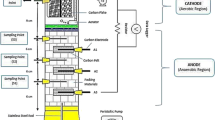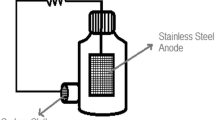Abstract
This study highlights the potential of the microbial fuel cell (MFC)-based bio-electro-Fenton (BEF) process as an efficient and highly adaptable strategy for wastewater treatment. The research aims to optimize the pH of the cathodic chamber (3–7) and catalyst doses (Fe) (0–18.56%) on the graphite felt (GF) cathode, and examine the effect of operating parameters on chemical oxygen demand (COD) removal, mineralization efficiency, pharmaceuticals (ampicillin, diclofenac, and paracetamol) removal, and power generation. The study found that lower pH and higher catalyst dosage on the GF led to better performance of the MFC-BEF system. Under neutral pH, mineralization efficiency, paracetamol removal, and ampicillin removal were enhanced by 1.1 times, and power density improved by 1.25 times as catalyst dosage increased from 0 to 18.56%. Additionally, employing full factorial design (FFD) statistical optimization, the study identifies the optimized conditions for maximum COD removal, mineralization efficiency, and power generation, which are determined to be a pH of 3.82 and a catalyst dose of 18.56%.








Similar content being viewed by others
Data availability
All data generated or analyzed during this study are included in this published article.
References
Al-Qaim FF, Abdullah MP, Othman MR (2012) Analysis of different therapeutic classes using liquid chromatography - mass spectrometry in aquatic environment: a review. Int J Pharm Pharm Sci 4:3–11
Asghar A, Raman AAA, Daud WMAW (2015) Advanced oxidation processes for in-situ production of hydrogen peroxide/hydroxyl radical for textile wastewater treatment: a review. J Clean Prod 87:826–838. https://doi.org/10.1016/j.jclepro.2014.09.010
Bagchi S, Behera M (2020a) Performance evaluation of microbial fuel cells employing ceramic separator of different surface area modified with mineral cation exchanger. SN Appl Sci 2:1–8. https://doi.org/10.1007/s42452-020-2095-7
Bagchi S, Behera M (2020b) Evaluating the effect of the antibiotic ampicillin on performance of a low-cost microbial fuel cell. J Hazard Toxic Radioact Waste 24:04020011. https://doi.org/10.1061/(asce)hz.2153-5515.0000516
Behera M, Ghangrekar MM (2017) Optimization of operating conditions for maximizing power generation and organic matter removal in microbial fuel cell. J Environ Eng 143:04016090. https://doi.org/10.1061/(asce)ee.1943-7870.0001179
Brillas E, Sirés I, Oturan MA (2009) Electro-Fenton process and related electrochemical technologies based on Fenton’s reaction chemistry. Chem Rev 109:6570–6631. https://doi.org/10.1021/cr900136g
Fu L, You S-J, Yang F-L et al (2010) Synthesis of hydrogen peroxide in microbial fuel cell. J Chem Technol Biotechnol 85:715–719
Ghasemi M, Shahgaldi S, Ismail M et al (2011) Activated carbon nanofibers as an alternative cathode catalyst to platinum in a two-chamber microbial fuel cell. Int J Hydrogen Energy 36:13746–13752. https://doi.org/10.1016/j.ijhydene.2011.07.118
Giri AS, Golder AK (2014) Fenton, photo-Fenton, H2O2 photolysis, and TiO2 photocatalysis for dipyrone oxidation: drug removal, mineralization, biodegradability, and degradation mechanism. Ind Eng Chem Res 53:1351–1358. https://doi.org/10.1021/ie402279q
Guo R, Xie X, Chen J (2015) The degradation of antibiotic amoxicillin in the Fenton-activated sludge combined system. Environ Technol (United Kingdom) 36:844–851. https://doi.org/10.1080/09593330.2014.963696
Jung YS, Lim WT, Park JY, Kim YH (2009) Effect of pH on Fenton and Fenton-like oxidation. Environ Technol 30:183–190. https://doi.org/10.1080/09593330802468848
Khalili HB, Mohebbi-Kalhori D, Afarani MS (2017) Microbial fuel cell (MFC) using commercially available unglazed ceramic wares: low-cost ceramic separators suitable for scale-up. Int J Hydrogen Energy 42:8233–8241. https://doi.org/10.1016/j.ijhydene.2017.02.095
Kumar A, Kumar A, Sharma G et al (2018) Quaternary magnetic BiOCl/g-C3N4/Cu2O/Fe3O4 nano-junction for visible light and solar powered degradation of sulfamethoxazole from aqueous environment. Chem Eng J 334:462–478. https://doi.org/10.1016/j.cej.2017.10.049
Kumar A, Rana A, Sharma G et al (2019) Recent advances in nano-Fenton catalytic degradation of emerging pharmaceutical contaminants. J Mol Liq 290:111177. https://doi.org/10.1016/j.molliq.2019.111177
Li X, Chen S, Angelidaki I, Zhang Y (2018) Bio-electro-Fenton processes for wastewater treatment: advances and prospects. Chem Eng J 354:492–506. https://doi.org/10.1016/j.cej.2018.08.052
Ling T, Huang B, Zhao M et al (2016) Repeated oxidative degradation of methyl orange through bio-electro-Fenton in bioelectrochemical system (BES). Bioresour Technol 203:89–95. https://doi.org/10.1016/j.biortech.2015.12.031
Liu Y, Zhao Y, Wang J (2021) Fenton/Fenton-like processes with in-situ production of hydrogen peroxide/hydroxyl radical for degradation of emerging contaminants: advances and prospects. J Hazard Mater 404:124191. https://doi.org/10.1016/j.jhazmat.2020.124191
Logan BE (2012) Essential data and techniques for conducting microbial fuel cell and other types of bioelectrochemical system experiments. Chemsuschem 5:988–994. https://doi.org/10.1002/cssc.201100604
Mirzaei A, Chen Z, Haghighat F, Yerushalmi L (2017) Removal of pharmaceuticals from water by homo/heterogonous Fenton-type processes – a review. Chemosphere 174:665–688. https://doi.org/10.1016/j.chemosphere.2017.02.019
Mussa ZH, Al-Qaim FF, Jawad AH et al (2022) A comprehensive review for removal of non-steroidal anti-inflammatory drugs attained from wastewater observations using carbon-based anodic oxidation process. Toxics 10:598. https://doi.org/10.3390/toxics10100598
Nidheesh PV, Gandhimathi R (2012) Trends in electro-Fenton process for water and wastewater treatment: an overview. Desalination 299:1–15. https://doi.org/10.1016/j.desal.2012.05.011
Raychaudhuri A, Behera M (2021) Enhancement of bioelectricity generation by integrating acidogenic compartment into a dual-chambered microbial fuel cell during rice mill wastewater treatment. Process Biochem 105:19–26. https://doi.org/10.1016/j.procbio.2021.03.003
Raychaudhuri A, Behera M (2020a) Ceramic membrane modified with rice husk ash for application in microbial fuel cells. Electrochim Acta 363:137261. https://doi.org/10.1016/j.electacta.2020.137261
Raychaudhuri A, Behera M (2020b) Comparative evaluation of methanogenesis suppression methods in microbial fuel cell during rice mill wastewater treatment. Environ Technol Innov 17:100509. https://doi.org/10.1016/j.eti.2019.100509
Raychaudhuri A, Behera M (2020c) Review of the process optimization in microbial fuel cell using design of experiment methodology. J Hazard Toxic Radioact Waste 24:04020013. https://doi.org/10.1061/(ASCE)HZ.2153-5515.0000503
Raychaudhuri A, Behera M (2023) Biodegradation and power production kinetics in microbial fuel cell during rice mill wastewater treatment. Fuel 339:126904. https://doi.org/10.1016/j.fuel.2022.126904
Sajana TK, Ghangrekar MM, Mitra A (2014) Effect of operating parameters on the performance of sediment microbial fuel cell treating aquaculture water. Aquac Eng 61:17–26. https://doi.org/10.1016/j.aquaeng.2014.05.004
Sathe SM, Chakraborty I, SankarCheela VR et al (2021) A novel bio-electro-Fenton process for eliminating sodium dodecyl sulphate from wastewater using dual chamber microbial fuel cell. Bioresour Technol 341:125850. https://doi.org/10.1016/j.biortech.2021.125850
Sathe SM, Chakraborty I, Dubey BK, Ghangrekar MM (2022) Microbial fuel cell coupled Fenton oxidation for the cathodic degradation of emerging contaminants from wastewater: applications and challenges. Environ Res 204:112135. https://doi.org/10.1016/j.envres.2021.112135
Tao HC, Wei XY, Zhang LJ et al (2013) Degradation of p-nitrophenol in a BES-Fenton system based on limonite. J Hazard Mater 254–255:236–241. https://doi.org/10.1016/j.jhazmat.2013.03.061
Zhang L, Yin X, Li SFY (2015a) Bio-electrochemical degradation of paracetamol in a microbial fuel cell-Fenton system. Chem Eng J 276:185–192. https://doi.org/10.1016/j.cej.2015.04.065
Zhang Y, Wang Y, Angelidaki I (2015b) Alternate switching between microbial fuel cell and microbial electrolysis cell operation as a new method to control H2O2 level in Bioelectro-Fenton system. J Power Sources 291:108–116. https://doi.org/10.1016/j.jpowsour.2015.05.020
Zhang M hui, Dong H, Zhao L et al (2019) A review on Fenton process for organic wastewater treatment based on optimization perspective. Sci Total Environ 670:110–121. https://doi.org/10.1016/j.scitotenv.2019.03.180
Zhu X, Ni J (2009) Simultaneous processes of electricity generation and p-nitrophenol degradation in a microbial fuel cell. Electrochem Commun 11:274–277. https://doi.org/10.1016/j.elecom.2008.11.023
Zhuang L, Zhou S, Li Y et al (2010) In situ Fenton-enhanced cathodic reaction for sustainable increased electricity generation in microbial fuel cells. J Power Sources 195:1379–1382. https://doi.org/10.1016/j.jpowsour.2009.09.011
Funding
The fellowship received by the first author and the second author from MHRD is duly acknowledged.
Author information
Authors and Affiliations
Contributions
Sruthi V Roy: conceptualization, investigation, data collection, analysis, writing—original draft. Aryama Raychaudhuri: investigation, data analysis, data representation, writing—review and editing. Manaswini Behera: supervision, conceptualization, writing—review and editing. Remya Neelancherry: supervision, writing—review and editing.
Corresponding author
Ethics declarations
Ethics approval
None of the authors of this article conducted any studies involving animals.
Consent to participate
As no human subjects were involved in this study, consent to participate was not applicable.
Consent to Publish
Not applicable.
Competing interests
The authors declare no competing interests.
Additional information
Responsible Editor: Weiming Zhang
Publisher's note
Springer Nature remains neutral with regard to jurisdictional claims in published maps and institutional affiliations.
Rights and permissions
Springer Nature or its licensor (e.g. a society or other partner) holds exclusive rights to this article under a publishing agreement with the author(s) or other rightsholder(s); author self-archiving of the accepted manuscript version of this article is solely governed by the terms of such publishing agreement and applicable law.
About this article
Cite this article
Roy, S.V., Raychaudhuri, A., Behera, M. et al. Elimination of pharmaceuticals from wastewater using microbial fuel cell-based bio-electro-Fenton process. Environ Sci Pollut Res (2023). https://doi.org/10.1007/s11356-023-28424-w
Received:
Accepted:
Published:
DOI: https://doi.org/10.1007/s11356-023-28424-w




